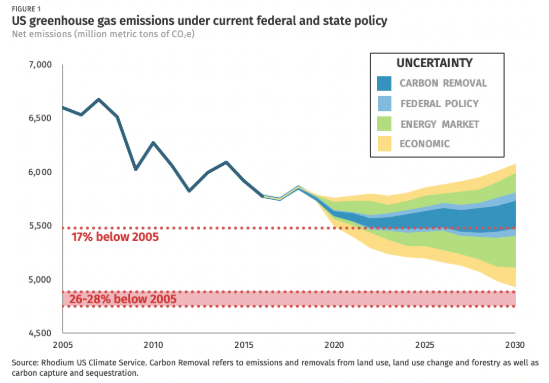
In 2009, the United States agreed to reduce carbon emissions in 2020 by 17% compared to 2005 emissions as part of an international deal known as the Copenhagen Accord. That is very likely not going to happen.
More likely, according to a new report from Rhodium Group, is a reduction in the range of 12% to 16%. And by 2025, the U.S. Paris Agreement target of a promise to reduce emissions by 26% to 28% compared to 2005 emissions, U.S. emissions are likely to fall in a range of 12% to 19%.
The Trump administration’s 2017 withdrawal from the Paris Agreement and further insecurity about the U.S. commitment to lower carbon emissions could reduce the U.S. total by as little as 11% or as much as 21%. According to Rhodium Group, even the 2018 election of progressive climate leaders won’t “meaningfully impact emissions before 2025.” Lacking a strong federal-level push, the effect of aggressive state-level plans is expected to be limited.
The report notes four major trends working against lower emissions. First is the low price of natural gas. Combined with falling costs for renewable electric power generation, natural gas prices could become a threat to renewables like solar and wind that emit no carbon. Low natural gas prices also threaten the retirement of 45% of U.S. nuclear power generation that currently accounts for about 12% of the country’s zero-emissions generation.
Second, Americans love affair with larger, less fuel-efficient vehicles are on track to fall short of emissions targets in the transportation sector. In the best case, falling battery prices would make electric vehicles more attractive but only about 16% of new U.S. vehicle sales would be electrified in 2025. At that percentage, tailpipe emissions fall by just 12% below 2005 levels. If battery prices decline at a slower rate, only 6% of new sales in 2025 would include electric vehicles and emission reductions would fall by just 8%.
In addition to its effect on electricity generation, low prices for natural gas also threaten to increase emissions from industries such as steel, cement, and chemicals. Cheap gas increases industrial emissions by 7% while higher gas prices could curb the increase to just 1%.
Finally, there isn’t much time left for state and, especially, federal policy to have a beneficial effect on emissions by 2025. The following chart from Rhodium Group gives the ranges of emissions reductions between now and 2030.
It’s also worth noting that the United States is among the 25 countries that produce the most carbon emissions.
Is Your Money Earning the Best Possible Rate? (Sponsor)
Let’s face it: If your money is just sitting in a checking account, you’re losing value every single day. With most checking accounts offering little to no interest, the cash you worked so hard to save is gradually being eroded by inflation.
However, by moving that money into a high-yield savings account, you can put your cash to work, growing steadily with little to no effort on your part. In just a few clicks, you can set up a high-yield savings account and start earning interest immediately.
There are plenty of reputable banks and online platforms that offer competitive rates, and many of them come with zero fees and no minimum balance requirements. Click here to see if you’re earning the best possible rate on your money!
Thank you for reading! Have some feedback for us?
Contact the 24/7 Wall St. editorial team.

 24/7 Wall St.
24/7 Wall St.


